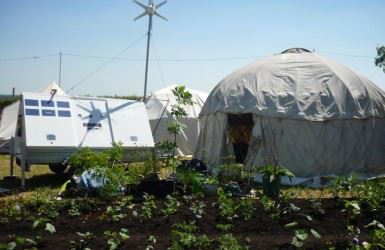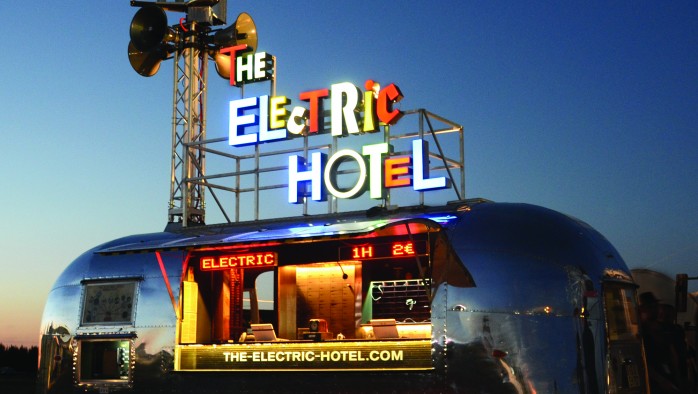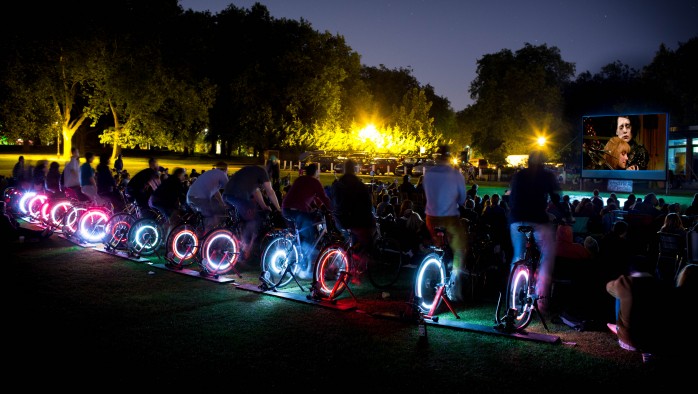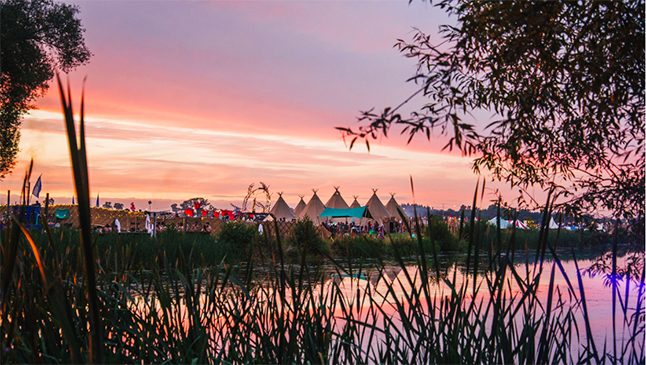Experimenting with smart grids and new solutions
The festival is powered by 100% renewable energy, but is still seeking to increase energy efficiency and reduce dependency on biofuels. They aim to phase out use of biofuels in the shortest possible timeframe, using instead what they hope will be the UK’s first integrated power system for festivals. They believe in reducing dependency on liquid fuels and encouraging the development of an alternative fuel economy. In 2012, Sunrise Festival used a mix of Waste Vegetable Oil (WVO), solar power, wind power and pedal power. As technology gets better and larger amounts of energy can be produced from sources such as solar and wind the festival plans to make use of them even more. This alternative energy provision is assured by preferentially booking traders and production crew who run their equipment off solar, wind or pedal power. Sunrise Festival also continues to raise money for environmental projects and invest in renewable energy technologies.
For the 2013 festival they planned to bring together high-spec battery technology with more traditional waste vegetable oil generators and a combination of solar and wind power, to create a site-wide power system that is energy efficient and low impact. This is the type of innovative power provision at festivals that shows their true commitment to sustainability and the creation of “Another World”.
As well as improving this system, they carry out thorough monitoring of the power systems onsite to recognize where power may be being wasted. This monitoring also ensures the information needed to improve further in the future was being gathered. Revelations about overspeccing of equipment and inefficiency from individual venues, traders and other users from the 2012 power surveys gave a focus for improvements for the 2013 event.
Charging ahead! A mini, mobile phone charging power station.
Brainchild of artist Sebastian Fleiter it is a shining example of audience engagement in renewable energy provision. It offers an interactive service for charging phones in the form of pedal power for a free, quick, and fun energy supply at festivals. The brightly polished 1960s chrome camper van also has solar cells, wind turbines and a pump storage hydro power unit which allows it to run 400 mobile phone charging points with lockers that can be availed of for a small fee, allowing them to charge over 3000 phones a day.
Technical challenges in the first year of this innovative and ambitious non-profit business included the underestimation of the requirements for mobile phone charging. They found that standards for phones are not as common as you might think, and there are many different socket types.
To overcome this difficulty around half of all charging points can be used with any model, while the other half have adapters for mobile phones with unique sockets. This service has ended up being a pragmatic idea for providing renewable electricity to festival goers, originating from an idea incorporating the worlds of art and technology.
Currently, new power generators are being developed for The Electric Hotel, and they have received funding from the European Union EFRE programme, as well as various awards for their endeavours.
The Electric Hotel not only provides an affordable and necessary renewable energy powered service, but simultaneously informs and engages festival goers in alternative energy procurement.
Pedal power energy, environmentalism, engagement, education and art.
Electric pedals came about as a solution to engaging people in an understanding and appreciation of resources and energy consumption. The simplicity of the idea is what first captured Colin Tonks’ imagination: you pedal, it generates electricity! The realisation of how effective this simple process of cause and effect is what got them started. What makes them different to many other pedal powered renewable energy alternatives at outdoor events is that people can bring their own bikes along and it can be attached to the generator there and then. They see this interactive approach to energy provision at festivals as a way to engage people, including children, in thinking about our energy supply and the alternatives to fossil fuels that are available.
Electric Pedals describe themselves as a group of artists, physicists, educationalists & environmentalists using bicycles to educate, helping to build community spirit while giving a little hug to the planet. They have seen year on year growth in interest in the sustainable service they supply. In recent years their cycle powered cinema has seen high demand from local councils for various creative productions and educational activities centred on sustainable energy. They also branched out with the development of an innovative pedal powered rucksack cinema that is bringing educational messages to some of the poorest and most remote parts of the world.
In the future they hope to teach people more broadly how to reduce waste in all its forms. They want to share skills and equip people with the know-how they need to live sustainably.
Success in renewable energy
Over the last five years, Shambala has consistently reduced their fuel dependency by transitioning to renewables and improving on efficiency. In 2013, Shambala was powered by 93% WVO bio-diesel, 1% solar and 6% red diesel – 100% of which was consumed by tower lights. The ambition to be 100% renewable was achieved in 2014 by using biofuel and solar hybrid systems across the site. Onsite biodiesel consumption was reduced by 20% from 2013 to 2014 by using hybrid systems, and there was a 380% kWh increase of renewable energy, which included stages run completely on solar and pedal power.
To assist in reducing the over-specification of generators, Shambala works with their power supplier to gather the power requirements of all end-users. It is also built into their contract that fuel savings are expected year-on-year, with a fixed fee on biofuel costs to create an incentive for the contractor to reduce usage wherever possible. In addition Shambala stipulate detailed energy monitoring throughout the event, a generator-by-generator post event report, and recommendations for future efficiency gains.
In 2015, the set-up included 22 bio-diesel generators, the full range of Firefly’s Cygnus Hybrid Power, 35 portable solar fold-arrays and 10 power packs. All of the site lighting was LED, 12km of festoon lighting and 105 LED Floods; the tower lights were all HPG.
Shambala Festival has reduced its energy-related GHG emissions per audience day by 39.5% between 2013 and 2014, and has reduced its overall onsite carbon footprint by 81% over 5 years. In 2015, energy (including bottled gas for traders) accounted for 19.6% of the onsite carbon footprint and only 8.53% of the overall footprint when including travel.
An analysis of the costs of energy at the festival over seven years shows that budget per person per day for energy has not increased in real terms, representing a saving if inflation and fuel costs rises are accounted for. Whilst the costs of certain items of equipment hire have been higher comparable to traditional diesel generators in some years, the reduction in total equipment requirements and generator sizes — due to efficiency savings — and in fuel use has outweighed these resulting in cost savings overall.
Thanks to Shambala for the information for this case study.




